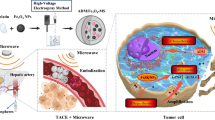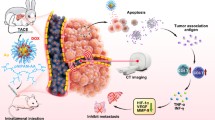Abstract
Trans-catheter arterial embolization, as a minimally invasive therapy strategy, has become a choice for treating liver cancer. Development of embolic agents integrated with therapy and imagining functions is desired. Herein, magnetic polyvinyl alcohol (PVA) microspheres as embolic agents are prepared by emulsification method. The diameter of the magnetic PVA microspheres ranges from 10 to 110 μm, and the required size can be obtained by sieving. The temperature of magnetic PVA microspheres suspension could stabilize at 49 °C under the applied magnetic field, which indicates the microspheres have self-regulating temperature hyperthermia characteristic due to the application of magnetic nanoparticles with low Curie point. In addition, magnetic PVA microspheres possess obvious contrast effects on CT and T2-weighted imaging due to the existence of magnetic nanoparticles. Cytotoxicity assay indicates the survival rate of cells cultured with leach liquor of 30 mg/mL PVA/MNPs microspheres is 97.4%, which shows the magnetic microspheres have good cell biocompatibility. The developed magnetic microspheres have the potential to realize embolization, self-regulating temperature hyperthermia, and CT/MR imaging simultaneously in interventional therapy.









Similar content being viewed by others
References
Bosch FX, Ribes J, Díaz M, Cléries R (2004) Primary liver cancer: worldwide incidence and trends. Gastroenterology 127:5–16. https://doi.org/10.1053/j.gastro.2004.09.011
Ferlay J, Soerjomataram I, Dikshit R, Eser S, Mathers C, Rebelo M, Parkin DM, Forman D, Bray F (2015) Cancer incidence and mortality worldwide: Sources, methods and major patterns in GLOBOCAN 2012. Int J Cancer 136:359–386. https://doi.org/10.1002/ijc.29210
Yamada R, Kishi K, Sato M, Sonomura T, Nishida N, Tanaka K, Shioyama Y, Terada M, Kimura M (1995) Transcatheter arterial chemoembolization (TACE) in the treatment of unresectable liver cancer. World J Surg 19:795–800. https://doi.org/10.1007/BF00299773
Yamada R, Sato M, Kawabata M, Nakatsuka H, Nakamura K, Takashima S (1983) Hepatic artery embolization in 120 patients with unresectable hepatoma. Radiology 148:397–401. https://doi.org/10.1148/radiology.148.2.6306721
Kan ZX, Wallace S (1994) Sinusoidal embolization: impact of iodized oil on hepatic microcirculation. J Vasc Interv Radiol 5:881–886. https://doi.org/10.1016/S1051-0443(94)71629-8
Chen Y, Yang Y, Xu WJ, Xin YJ, Wang YN, Zhou X, Li X (2020) Clinical application of interventional embolization in tumor-associated hemorrhage. Ann. Transl. Med. 8:394. https://doi.org/10.21037/atm.2020.03.69
Awad SA, Khalaf EM (2019) Investigation of photodegradation preventing of polyvinyl alcohol/nanoclay composites. J Polym Environ 27:1908–1917. https://doi.org/10.1007/s10924-019-01470-7
Awad SA, Khalaf EM (2018) Evaluation of the photostabilizing efficiency of polyvinyl alcohol–zinc chloride composites. J Thermoplast Compos Mater 33:69–84. https://doi.org/10.1177/0892705718804585
Awad SA (2021) Enhancing the thermal and mechanical characteristics of polyvinyl alcohol (PVA)-Hemp protein particles (HPP) composites. Int Polym Process. https://doi.org/10.1515/ipp-2020-3974
Awad S (2021) Investigation of chemical modification and enzymatic degradation of poly (vinyl alcohol)/hemoprotein particle composites. J Turk Chem Soc Sect A. https://doi.org/10.18596/jotcsa.878495
Begum MHA, Hossain MM, Gafur MA, Kabir ANMH, Tanvir NI, Molla MR (2019) Preparation and characterization of polyvinyl alcohol–starch composites reinforced with pulp. SN Appl Sci. https://doi.org/10.1007/s42452-019-1111-2
Santi R, Cigada A, Del Curto B, Fare S (2019) Modulable properties of PVA/cellulose fiber composites. J Appl Biomater Funct Mater. https://doi.org/10.1177/2280800019831224
Osuga K, Maeda N, Higashihara H, Hori S, Nakazawa T, Tanaka K, Nakamura M, Kishimoto K, Ono Y, Tomiyama N (2012) Current status of embolic agents for liver tumor embolization. Int J Clin Oncol 17:306–315. https://doi.org/10.1007/s10147-012-0445-1
Lee SH, Lin CY, Hsu YC, Liu YS, Chuang MT, Ou MC (2020) Comparison of the efficacy of two microsphere embolic agents for transcatheter arterial chemoembolization in hepatocellular carcinoma patients. Cancer Res Treat 52:24–30. https://doi.org/10.4143/crt.2019.018
Leyon JJ, Littlehales T, Rangarajan B, Hoey ET, Ganeshan A (2014) Endovascular embolization: review of currently available embolization agents. Curr Probl Diagn Radiol 43:35–53. https://doi.org/10.1067/j.cpradiol.2013.10.003
Kim HC, Kim TK, Sung KB, Yoon HK, Kim PN, Ha HK, Kim AY, Kim HJ, Lee MG (2003) Preoperative evaluation of hepatocellular carcinoma: Combined use of CT with arterial portography and hepatic arteriography. Am J Roentgenol 180:1593–1599. https://doi.org/10.2214/ajr.180.6.1801593
Soyer P, Bluemke DA, Fishman EK (1994) CT during arterial portography for the preoperative evaluation of hepatic tumors: how, when, and why? Am J Roentgenol 163:1325–1331. https://doi.org/10.2214/ajr.163.6.7992722
McIntire GL, Bacon ER, Toner JL, Cornacoff JB, Losco PE, Illig KJ, Nikula KJ, Muggenburg BA, Ketai L (1998) Pulmonary delivery of nanoparticles of insoluble, iodinated CT X-ray contrast agents to lung draining lymph nodes in dogs. J Pharm Sci 87:1466–1470. https://doi.org/10.1021/js980060r
Brink JA (2003) Use of high concentration contrast media (HCCM): Principles and rationale-body CT. Eur J Radiol 45:53–58. https://doi.org/10.1016/S0720-048X(02)00362-5
Wang Q, Qian K, Liu SS, Yang YJ, Liang B, Zheng CS, Yang XL, Xu HB, Shen AQ (2015) X-ray visible and uniform alginate microspheres loaded with in situ synthesized BaSO4 nanoparticles for in vivo transcatheter arterial embolization. Biomacromol 16:1240–1246. https://doi.org/10.1021/acs.biomac.5b00027
Li XH, Ji XF, Chen K, Ullah MW, Li B, Cao JM, Xiao L, Xiao J, Yang G (2021) Immobilized thrombin on X-ray radiopaque polyvinyl alcohol/chitosan embolic microspheres for precise localization and topical blood coagulation. Bioact Mater 6:2105–2119. https://doi.org/10.1016/j.bioactmat.2020.12.013
Li Z, Kawashita M, Araki N, Mitsumori M, Hiraoka M, Doi M (2011) Preparation of magnetic iron oxide nanoparticles for hyperthermia of cancer in a FeCl2-NaNO3-NaOH aqueous system. J Biomater Appl 25:643–661. https://doi.org/10.1177/0885328209351136
Maehara T, Konishi K, Kamimori T, Aono H, Naohara T, Kikkawa H, Watanabe Y, Kawachi K (2014) Heating of ferrite powder by an AC magnetic field for local hyperthermia. Jpn J Appl Phys 41:1620–1621. https://doi.org/10.1143/JJAP.41.1620
Rashid AU, Humayun A, Manzoor S (2017) MgFe2O4/ZrO2 composite nanoparticles for hyperthermia applications. J Magn Magn Mater 428:333–339. https://doi.org/10.1016/j.jmmm.2016.12.119
Gupta AK, Gupta M (2005) Synthesis and surface engineering of iron oxide nanoparticles for biomedical applications. Biomaterials 26:3995–4021. https://doi.org/10.1016/j.biomaterials.2004.10.012
Li JJ, Wang JH, Li JY, Yang X, Wan JL, Zheng CS, Du Q, Zhou GF, Yang XL (2021) Fabrication of Fe3O4@PVA microspheres by one-step electrospray for magnetic resonance imaging during transcatheter arterial embolization. Acta Biomater 131:532–543. https://doi.org/10.1016/j.actbio.2021.07.006
Chang D, Lim M, Goos JACM, Qiao RR, Ng YY, Mansfeld FM, Jackson M, Davis TP, M. (2018) Kavallaris, biologically targeted magnetic hyperthermia: potential and limitations. Front Pharmacol 9:831. https://doi.org/10.3389/fphar.2018.00831
Qiu S, Nai JG, Sun DK, Zhao S, Sun JF, Guo ZB, Hu K, Gu N (2016) Synthesis and characterization of magnetic polyvinyl alcohol (PVA) hydrogel microspheres for the embolization of blood vessel. IEEE Trans Biomed Eng 63:730–736. https://doi.org/10.1109/TBME.2015.2469735
McMichael RD, Shull RD, Swartzendruber LJ, Bennett LH, Watson RE (1992) Magnetocaloric effect in superparamagnets. J Magn Magn Mater 111:29–33. https://doi.org/10.1016/0304-8853(92)91049-Y
Jaque D, Martínez Maestro L, del Rosal B, Haro-Gonzalez P, Benayas A, Plaza JL, Martín Rodríguez E, García SoléJ (2014) Nanoparticles for photothermal therapies. Nanoscale 6:9494–9530. https://doi.org/10.1039/C4NR00708E
Tong S, Quinto CA, Zhang LL, Mohindra P, Bao G (2017) Size-dependent heating of magnetic iron oxide nanoparticles. ACS Nano 11:6808–6816. https://doi.org/10.1021/acsnano.7b01762
Yu XG, Yang RP, Wu CW, Zhang W (2020) Effect of chromium ion substitution of ZnCo ferrites on magnetic induction heating. J Alloys Compd 830:154724. https://doi.org/10.1016/j.jallcom.2020.154724
Zhang W, Yu XG, Li H, Dong DL, Zuo XD, Wu CW (2019) Magnetic nanoparticles with low Curie temperature and high heating efficiency for self-regulating temperature hyperthermia. J Magn Magn Mater 489:165382. https://doi.org/10.1016/j.jmmm.2019.165382
Zhang W, Zuo XD, Niu Y, Wu CW, Wang SP, Guan S, Silva SRP (2017) Novel nanoparticles with Cr3+ substituted ferrite for self-regulating temperature hyperthermia. Nanoscale 9:13929–13937. https://doi.org/10.1039/C7NR02356A
Hassan CM, Peppas NA (2000) Structure and applications of poly (vinyl alcohol) hydrogels produced by conventional crosslinking or by freezing/thawing methods. Biopolymers 153:37–65. https://doi.org/10.1007/3-540-46414-X_2
Alakanandana A, Subrahmanyam AR, Siva Kumar J (2016) Structural and electrical conductivity studies of pure PVA and PVA doped with succinic acid polymer electrolyte system. Mater. Today: Proc. 3:3680–3688. https://doi.org/10.1016/j.matpr.2016.11.013
Mansur HS, Sadahira CM, Souza AN, Mansur AAP (2008) FTIR spectroscopy characterization of poly (vinyl alcohol) hydrogel with different hydrolysis degree and chemically crosslinked with glutaraldehyde. Mater Sci Eng C 28:539–548. https://doi.org/10.1016/j.msec.2007.10.088
Ferk G, Drofenik M, Lisjak D, Hamler A, Jaglicic Z, Makovec D (2014) Synthesis andcharacterization of Mg1+xFe2–2xTixO4 nanoparticles with an adjustable curiepoint. J Magn Magn Mater 350:124–128. https://doi.org/10.1016/j.jmmm.2013.09.037
Sun C, Lee Jerry SH, Zhang MQ (2008) Magnetic nanoparticles in MR imaging and drug delivery. Adv. Drug Delivery Rev. 60:1252–1265. https://doi.org/10.1016/j.addr.2008.03.018
Wu AG, Ou P, Zeng LY (2010) Biomedical applications of magnetic nanoparticles. NANO 5:245–270. https://doi.org/10.1007/978-3-540-85387-9_5
Okuhata Y (1999) Delivery of diagnostic agents for magnetic resonance imaging. Adv Drug Delivery Rev 37:121–137. https://doi.org/10.1016/S0169-409X(98)00103-3
Li Z, Liang S, Liu RQ, Yuan TM, Zhang SL, Xu ZS, Xu HB (2016) Facile preparation of multifunctional uniform magnetic microspheres for T1–T2 dual modal magnetic resonance and optical imaging. Colloids Surf B 144:344–354. https://doi.org/10.1016/j.colsurfb.2016.04.014
Sun XY, Dai HX, Guo P, Sha XY (2019) Biocompatibility of a new kind of polyvinyl alcohol embolic microspheres: in vitro and In vivo evaluation. Mol Biotechnol 61:610–621. https://doi.org/10.1007/s12033-019-00166-6
Acknowledgements
This work was supported by National Key R&D Project of China (2018YFA0704103, 2018YFA0704104), National Natural Science Foundation China (11772086, U1908233), and Fundamental Research Funds for the Central Universities (DUT21TD105).
Author information
Authors and Affiliations
Corresponding author
Ethics declarations
Conflict of interest
The authors declare no competing interests.
Additional information
Publisher's Note
Springer Nature remains neutral with regard to jurisdictional claims in published maps and institutional affiliations.
Rights and permissions
About this article
Cite this article
Yin, P., Wei, C., Jin, X. et al. Magnetic polyvinyl alcohol microspheres with self-regulating temperature hyperthermia and CT/MR imaging for arterial embolization. Polym. Bull. 80, 2697–2711 (2023). https://doi.org/10.1007/s00289-022-04192-4
Received:
Revised:
Accepted:
Published:
Issue Date:
DOI: https://doi.org/10.1007/s00289-022-04192-4




